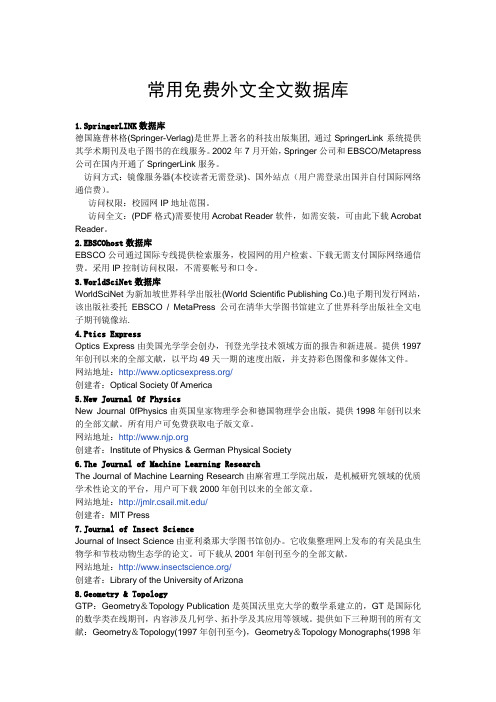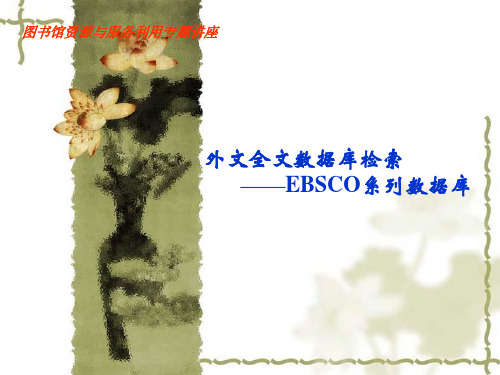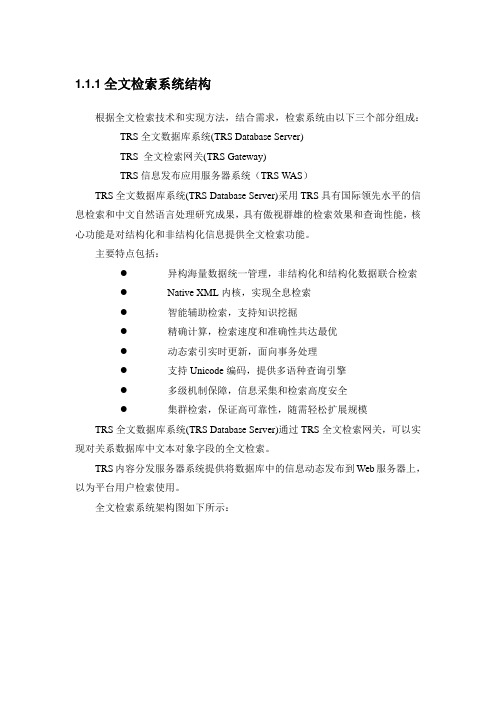英文数据库,全文检索 文档
英文常用全文数据库的检索

n包括生化研究方法、药物化学、有机化学、科学训练、普 通化学、环境化学、材料学、燃料与能源、环境科学、毒 物学、食品科学、药理与制药学、物理化学、植物学、工 程化学、微生物应用生物科技、应用化学、分子生物化 学、分析化学、聚合物、无机与原子能化学、资料系统计 算机科学、学科应用、农业学。
nanocomposites
p构造检索式:Abstract=polymer and Title=
nanocomposites
检索实例-2
p使用高级检索方式,检索过程如下:
检索实例-3
p检索结果
检索结果排序 检索结果现实条目
精炼检索结果
获取全文
其他全文数据库
SpringerLink-1
p德国施普林格出版集团(Springer)是世界上著名
获取该数据库的文摘题录信息,正式用户可以下载 全文,对于机构用户采用IP地址控制使用权限。
✓SDOL允许任何人免费使用其数据库,与付费用户的唯一区别是没
有下载全文的权限。
概况-3
p进入方式
直接点击进入
概况-4
p主页
检索技术-1
p布尔检索
n支持AND(逻辑与) 、 OR(逻辑或) 和NOT (逻辑 非)逻辑运算。检索词之间若没有算符和双引号,系统则 默认为AND关系。
ACS)创立于1876年,是世界上最大的科技协会之 一,其会员数超过16.3万,是世界上最权威的科技 信息来源之一。
pACS的期刊被ISI的期刊引证报告(JCR)评为“化
学领域中被引用次数最多的期刊”。
pACS出版的文献类型有图书、期刊、会议文献、新
闻等,其中期刊50种,最早回溯到1879年。
利用英文全文数据库

利用英文全文数据库利用英文全文数据库——Elsevier 进行文献信息检索示例1、检索课题名称:我国新农村沼气建设2、课题分析:中文关键词为:我国新农村,沼气,建设英文关键词为:country,biogas,development3、选择检索工具:Elsevier 数据库4、构建检索策略: country AND biogas AND development5、简述检索过程:选定在Elsevier 中期刊、图书、文摘数据库等全部文献资源中检索 1996 年以后的关于我国新农村沼气建设的相关文献。
利用确定的检索策略(waste water AND treatment),文献全文(含文献题目、摘要、关键词)中检索,检到 9735篇相关文献;在文献题目、摘要和关键词中检索,检索到984 篇相关文献;在文献关键词中检索到 137 篇相关文献;在文献题目中检索到 114篇相关文献。
6、整理检索结果:从以上文献中选择出2 条切题文献1.Biogas, renewable energy resource for PakistanSyed S. Amjid , , Muhammad Q. Bilal, Muhammad S. Nazir, Altaf Hussain Department of Livestock Management, University of Agriculture, Faisalabad, Pakistan Received 31 January Mechanical characteristics evaluation of biogas micro turbine power systems 2011; Accepted 20 February 2011. Available online 5 May 2011.2.Kwang-beom Hur , , Sang-kyu Rhim, Jung-keuk ParkKorea Electric Power Corporation (KEPCO), Korea Electric Power Research Institute (KEPRI), 103-16 Munji-dong, Yusung-gu, Daejeon 305-380, Republic of KoreaReceived 12 September 2007; revised 6 August 2009; Accepted 14 August 2009. Available online 20 August 2009.7、全文摘录选择一篇:Biogas, renewable energy resource for Pakistan一、篇名:Biogas, renewable energy resource for Pakistan二、著者:Syed S. Amjid , , Muhammad Q. Bilal, Muhammad S. Nazir, Altaf Hussain三、著者机构:Department of Livestock Management, University of Agriculture, Faisalabad, PakistanReceived 31 January 2011; Accepted 20 February 2011. Available online 5 May 2011。
英文全文数据库搜索

(四)利用英文全文数据库——Elsevier 进行文献信息检索示例1、检索课题名称:现代建筑结构体系研究2、课题分析:“现代建筑”属于本课题中的主体,其应用目标是“结构体系”的研究,而“研究”是句法修饰,故“研究”可不作为检索词,由此得出如下检索词(按其对课题影响程度排序):中文关键词为:1 现代建筑 2 结构体系英文关键词为:(1)Model architacture(2)Structure system3、选择检索工具:Elsevier 数据库4、构建检索策略:Model architacture Structure system5、简述检索过程:选定在 Elsevier 中期刊、图书、文摘数据库等全部文献资源中检索1996 年以后的关于现代建筑结构体系研究的相关文献。
利用确定的检索策略(Model architacture Structure system),文献全文(含文献题目、摘要、关键词)中检索,检到 8728 篇相关文献;在文献题目、摘要和关键词中检索,检索到 1212 篇相关文献;在文献关键词中检索到 134 篇相关文献;在文献题目中检索到 178 篇相关文献。
6、整理检索结果:从以上文献中选择出3 条切题文1 Component-based discriminative classification for hidden Markov models Original Research ArticlePattern Recognition, Volume 42, Issue 11, November 2009, Pages 2637-2648Manuele Bicego, Elżbieta Pe¸kalska, David M.J. Tax, Robert P.W. Duin| PDF (316 K)| Related articles| Related reference work articles2 Chapter3 Psychosocial Value of architacture Simulationfor Extended Spaceflight Original Research ArticleAdvances in architacture Biology and Medicine, Volume6, 1997, Pages 81-91Nick Kanas| Related articles | Related reference work articles3 Multidimensional Data Structures: Review and Outlook Original Research Article Advances in Computers, Volume 27, 1988, Pages 69-119S. Sitharama Iyengar, N.S.V. Rao, R.L. Kashyap, V.K. Vaishnavi| Related articles | Related reference work articles6、全文摘录选择一篇:Component-based discriminativeclassification for hidden Markov models一、篇名Component-based discriminative classification forhidden Markov models∙二、著者Manuele Bicego∙三、著者机构Elżbieta Pe¸kalska c,∙David M.J. Tax d,∙Robert P.W. Duin d∙四、文摘Hidden Markov models (HMMs) have been successfully applied to a wide range of sequence modeling problems. In the classification context, one of the simplest approaches is to train a single HMM per class. A test sequence is then assigned to the class whose HMM yields the maximum a posterior (MAP) probability. This generative scenario works well when the models are correctly estimated. However, the results can become poor when improper models are employed, due to the lack of prior knowledge, poor estimates, violated assumptions or insufficient training data.To improve the results in these cases we propose to combine the descriptive strengths of HMMs with discriminative classifiers.This is achieved by training feature-based classifiers in an HMM-induced vector space defined by specific components of individual hidden Markov models.We introduce four major ways of building such vector spaces and study which trained combiners are useful in which context. Moreover, we motivate and discuss the merit of our method in comparison to dynamic kernels, in particular, to the Fisher Kernel approach.∙五、关键词Keywords: Hidden Markov models;∙Discriminative classification;∙Dimensionality reduction;∙Hybrid models;∙Generative embeddings六、正文Component-based discriminative classification for hidden Markov models(首段)The HMMs are fitted to model a single class well, but this may lead to poor discrimination as the models are not optimized to differentiate among the classes. We propose to derive a fixed-dimensional feature space from the trained generative HMMs, in which discriminative classifiers are trained. We call this an HMMVS, equipped with the traditional norm and Euclidean metric. Every feature is extracted from aspecific HMM and conveys information about the corresponding class. In essence, this approach maps variable-length observation sequences into a vector space, and by doing this it integrates the modeling potential of one-class models with discriminative classifiers.HMMVS are based on “Component Information” features, CI s, which describe some relevant information extracted from particular components of the models, in relation to the input sequence O. A CI feature either characterizes some properties of the generation path of the sequence O through the model λc or the strength with which a specific component of λc “responds” to O. More formally, FCI(·,λc):Oc→Rmc is a model-dependent mapping defined by mc components derived from λc. The final HMM-induced vector space is a Cartesian product of all CI-spaces (one for each class)(末段)This application aims at the examination of EEG signals in order to distinguish between alcoholic and control subjects, /databases/eeg. Each subject was exposed to either a single stimulus (S1) or two stimuli (S1 and S2) which were pictures of objects chosen from the 1980s Snodgrass and Vanderwart picture set. When two stimuli were shown, they were presented in either a matched condition whereS1 was identical to S2 or in a non-matched condition where S1 differed from S2. There are three different versions of the data. In our case, we use the Large Data Set, denoted here denote it as Alcoholic data, in which the training and test sets are already pre-defined. The training set contains data for 10 alcoholic and 10 control subjects, with 10 runs per subject per paradigm. This results in 600 training sequences. The test data use the same alcoholic and control subjects, but with 10 out-of-sample runs per subject per paradigm. This results in 600 test sequences.Each data set contains measurements from 64 electrodes placed on the scalp sampled at 256 Hz (3.9-ms epoch) for 1 s. We select the first two channels only, as they permitted an almost perfect discrimination in the case of “small dataset”. All HMMs are trained with the same number of states七、参考文献Referenc1。
外文全文数据库使用指南

百科全书年鉴等参考工具书类
Encyclopedia Britannica Online WorldAlmanac (OCLC) History Reference Center (EBSCO) Foreign & International Law Resources
Database(HeinOnline)
February 2002. p 156-165
3. 利用EBSCO数据库,在期刊《Environmental Engineering Science》查找有关 活性污泥法处理废水污染的相关的有全文的资料。(Wastewater;activated sludge)
练习题(续)
4. 已知一篇论文信息如下: 出版物名称: Discrete Mathematics 文章名称: on the chromatic mumber of cube-like graphs 文章著者: Charles Payan 在我馆电子资源中能找到该文的电子版全文吗?如不能,请说明原因。
ASCE Research Library
收录的美国土木工程协会ASCE专业期刊回溯至1993年,会议录回溯 至1996年。
ACM Digital Library
收录美国计算机协会ACM的全文期刊41种,会议录180种。
APS/AIP(美国物理学会和美国物理联合会)电子期刊及会议录
收录AIP的13种期刊、APS的7种期刊以献。
如 Elsevier、Springer、IEL、ProQ告等
如Business Source Premier、World Bank Online Resources
查阅全文时要注意全文获取权限。
有的数据库在刊名或文章题名前附有说明权限的标识。 如springer标识刊”、“查找图书” 或“查找原文”,快速获取论文的电子版全文
常用免费外文全文数据库

常用免费外文全文数据库1.SpringerLINK数据库德国施普林格(Springer-Verlag)是世界上著名的科技出版集团, 通过SpringerLink系统提供其学术期刊及电子图书的在线服务。
2002年7月开始,Springer公司和EBSCO/Metapress 公司在国内开通了SpringerLink服务。
访问方式:镜像服务器(本校读者无需登录)、国外站点(用户需登录出国并自付国际网络通信费)。
访问权限:校园网IP地址范围。
访问全文:(PDF格式)需要使用Acrobat Reader软件,如需安装,可由此下载Acrobat Reader。
2.EBSCOhost数据库EBSCO公司通过国际专线提供检索服务,校园网的用户检索、下载无需支付国际网络通信费。
采用IP控制访问权限,不需要帐号和口令。
3.WorldSciNet数据库WorldSciNet为新加坡世界科学出版社(World Scientific Publishing Co.)电子期刊发行网站,该出版社委托EBSCO / MetaPress 公司在清华大学图书馆建立了世界科学出版社全文电子期刊镜像站.4.Ptics ExpressOptics Express由美国光学学会创办,刊登光学技术领域方面的报告和新进展。
提供1997年创刊以来的全部文献,以平均49天一期的速度出版,并支持彩色图像和多媒体文件。
网站地址:/创建者:Optical Society 0f America5.New Journal 0f PhysicsNew Journal 0fPhysics由英国皇家物理学会和德国物理学会出版,提供1998年创刊以来的全部文献。
所有用户可免费获取电子版文章。
网站地址:创建者:Institute of Physics & German Physical Society6.The Journal of Machine Learning ResearchThe Journal of Machine Learning Research由麻省理工学院出版,是机械研究领域的优质学术性论文的平台,用户可下载2000年创刊以来的全部文章。
外文全文数据库检索

2020/5/7
高级检索举例
26
2020/5/7
检索选项设置
27
2020/5/7
检索选项设置
28
2020/5/7
检索选项设置
29
2020/5/7
检索结果
30
2020/5/7
详细检索结果
31
2020/5/7
详细检索结果
32
2020/5/7
详细检索结果
33
2020/5/7
主题语和关键字
34
2020/5/7
Regional Business News:提供综合型地区商务 出版物的全文信息。Regional Business News 包 含 80 多篇涉及美国所有城市和农村的地区数据库简介
Research Starters – Business,Education, Sociology:专为高等高中学生、大学生和特选 研究生设计的学习和研究指南。包括各种特定 主题的、研究人员、学者和其他主题相关专家 编写的约 3,000 左右字数的摘要文章。
主题语扩展检索
35
EBSCO其他检索功能
EBSCOhost除了基本检索和高级检索模 式以外,还设置了其他检索功能。
利用各数据库的词表(科目术语)进行 检索。
按出版物浏览和检索。 图像检索功能。
2020/5/7
36
2020/5/7
利用英文全文数据库——Elsevier 进行文献信息检索

(3)EBSCO
4、构建检索策略:Brang Management and basic issues
5、简述检索过程:
(1)选定在 Elsevier 中期刊、图书、文摘数据库等全部文献资源中检索 1980 年以后的关于品牌管理若干基础问题研究相关文献。
Risk Management as a Tool for Sustainability
Frank C. Krysiak
Matthias Jahnke and Hans G. Nutzinger
ournal of Technology Assessment and Ethics of Science, 2001, Volume 1, Number 4, Pages 275-294
M.R. Theobald, W.J. Bealey, Y.S. Tang, A. Vallejo, M.A. Sutton
Close preview | PDF (520 K) | Related articles | Related reference work articles AbstractAbstract | Figures/TablesFigures/Tables | ReferencesReferencesAbstract
W. Andreas Hahn and Thomas Knoke
European Journal of Forest Research, 2010, Volume 129, Number 5, Pages 787-801
Download PDF (439.5 KB)View HTML
3.2. Model application and testing
专题四外文全文数据库检索——EBSCO系列数据库

❖
加强自身建设,增强个人的休养。2020年11月22日 上午3时 57分20.11.2220.11.22
❖
扩展市场,开发未来,实现现在。2020年11月22日 星期日 上午3时 57分17秒03:57:1720.11.22
❖
做专业的企业,做专业的事情,让自 己专业 起来。2020年11月上 午3时57分20.11.2203:57November 22, 2020
❖
安全在于心细,事故出在麻痹。20.11.2220.11.2203:57:1703:57:17November 22, 2020
❖
加强自身建设,增强个人的休养。2020年11月22日 上午3时 57分20.11.2220.11.22
❖
扩展市场,开发未来,实现现在。2020年11月22日 星期日 上午3时 57分17秒03:57:1720.11.22
❖ 收录范围涵盖自然科学、社会科学、人文和艺术、教育 学、医学等各类学科领域。包括 Business Source Premier (商业资源电子文献库)及Academic Search Premier(学术期刊数据库)等多个字库。
数据库简介
❖ Business Source Premier (商业资源电子文献 库)
❖ Vocational and Career Collection :
为服务于高等院校、社区大学、贸易机构和公众的专业技术图书 馆而设计。 该文集提供了 350 多种与贸易和工业相关的期刊的 全文收录。
❖ Library, Information Science & Technology Abstracts (LISTA):
❖ 高级检索(A5)d参va考nc文e S献ea(rchC)ited References) 检索
TRS全文检索系统文档

1.1.1 全文检索系统结构根据全文检索技术和实现方法,结合需求,检索系统由以下三个部分组成:TRS全文数据库系统(TRS Database Server)TRS 全文检索网关(TRS Gateway)TRS信息发布应用服务器系统(TRS WAS)TRS全文数据库系统(TRS Database Server)采用TRS具有国际领先水平的信息检索和中文自然语言处理研究成果,具有傲视群雄的检索效果和查询性能,核心功能是对结构化和非结构化信息提供全文检索功能。
主要特点包括:●异构海量数据统一管理,非结构化和结构化数据联合检索●Native XML内核,实现全息检索●智能辅助检索,支持知识挖掘●精确计算,检索速度和准确性共达最优●动态索引实时更新,面向事务处理●支持Unicode编码,提供多语种查询引擎●多级机制保障,信息采集和检索高度安全●集群检索,保证高可靠性,随需轻松扩展规模TRS全文数据库系统(TRS Database Server)通过TRS全文检索网关,可以实现对关系数据库中文本对象字段的全文检索。
TRS内容分发服务器系统提供将数据库中的信息动态发布到Web服务器上,以为平台用户检索使用。
全文检索系统架构图如下所示:TRS信息发布应用服务器系统全文检索系统架构图1.1.2 全文检索网关TRS 全文检索系统采用开放的三层体系架构设计,整个系统基于主流的操作系统。
数据层主要为关系型数据库和TRS全文数据库,关系型数据库主要进行存储和管理,而全文数据库实现检索,利用TRS Gateway可以将关系型数据库的数据在TRS全文数据库中建立全文索引,以实现结构化和非结构化数据的全文检索。
TRS全文数据库是TRS 公司自主研发的具有知识产权的产品,为了能够更好的提供全文检索和智能检索等应用功能,它其中包括多种词典支持:分词词典、主题词典、停用词典等。
应用层主要依据TRS全文数据库提供的全文检索功能实现平台所需的检索需求,并为表现层提供检索服务。
外文全文数据库检索

经济)都进行了全文收录。此数据库通过 EBSCOhost
每日更新。
3.Environment Complete 环境数据库
提供农业、生态系生态学、能源、可再生能源、海洋与淡 水科学、地理学、污染与废弃物管理、环境科技、环境法、公 共政策、社会影响、都市规划等相关领域的丰富内容。 Environment Complete 收录 1,700 多个国内与国际标题(包 括 1,094 个当前核心标题)超过 1,957,000 条可追溯到 20 世 纪 40 年代的记录以及超过 120 篇专题论文。本数据库还收录 超过 680 种期刊的全文。
Access 全文。
四.John Wiley 全文电子刊
John Wiley & Sons出版公司于1807年在美国创建,是有 200年历史的专业出版机构,出版高质量的学术期刊、过刊集、 图书、参考工具书、实验室指南、循证医学图书馆(The Cochrane Library)、数据库等。Wiley是众多国际知名学会 的合作伙伴,在化学、生命科学、医学、材料学以及工程技 术等领域学术文献的出版方面具有一定权威性。
覆盖的学科范围包括:化学、计算 机科学、经济学、工程学、环境科 学、地理学、法学、生命科学、数 学、医学以及物理学和天文学等。
二. Elsevier 电子期刊全(SDOS) ScienceDirect ()电子期刊是由 世界著名的荷兰Elsevier Science公司出版,是全球最 著名的科技医学全文数据库之一。
SpringerLink的数字资源有:全文电子期 刊 1500余种;图书和科技丛书(包括 Lecture Notes in Computer Science—— LNCS)13000种以上;超过200万条期刊文 章的回溯记录;最新期刊论文出版印刷前 的在线浏览。我馆只订购了其中的全文电 子期刊的全文下载权限。
英文数据库检索

Springer具体学科涉及:数学、物理与天文学、化学、生命科学、医学、工程学、计算机科学、环境科学、地球科学、经济学、法律。
右上部可以选择界面的语言实例1检索关于“乙醇的分离”方面的文献。
检索课题分析:从题目字面上看,检索式“乙醇and 分离”是正确的,但在化学化工上,将混合物分离(separation)的目的是为了提纯,因此加上提纯和纯化(purification,refine),检索策略就更全了。
所以我们将其检索式定为“(alcohol or ethanol)and (separ* or purific* or refin*)”,检索步骤如下图所示:在标题字段输入(alcohol or ethanol)and (separ* or purific* or refin*),在高级检索中输入检索式,如图所示。
检索关于“乙醇的分离”方面的文献。
检索课题分析:从题目字面上看,检索式“乙醇and 分离”是正确的,但在化学化工上,将混合物分离(separation)的目的是为了提纯,因此加上提纯和纯化(purification,refine),检索策略就更全了。
所以我们将其检索式定为“(alcohol or ethanol)and (separ* or purific* or refin*)”,检索步骤如下图所示:在标题字段输入(alcohol or ethanol)and (separ* or purific* or refin*),在高级检索中输入检索式。
EBSCO在线文献数据库,涉及自然科学、社会科学、人文和艺术等多种学术领域。
主要的数据库有:1、Academic Source Premier2、Business Source Premier3、Communication & Mass Media Complete4、EconLit5、PsycARTICLES如要跨库检索,可在页面上点击“选择数据库”标签,进入选库界面,复选后重新进入检索。
英文文献检索的方法及全文数据库的

IF
24189 25170 23.605 1037 1054
The theory, design and application of Control Systems. It shall encompass components, and the integration of these components, as are necessary for the construction of such systems. The word `systems' as used herein shall be interpreted to include physical, biological, organizational and other entities and combinations thereof, which can be represented through a mathematical symbolism. The Field of Interest: shall include scientific, technical, industrial or other activities that contribute to this field, or utilize the techniques or products of this field, subject, as the art develops, to additions, subtractions, or other modifications directed or approved by the IEEE Technical Activities Board.
Agricultural and Biological Sciences(138种) Biochemistry, Genetics, and Molecular Biology(156种) Business, Management and Accounting(84种) Chemistry(116种) Chemical Engineering(93种) Civil Engineering(58种) Computer Science(116种) Earth and Planetary Science(86种) Economics, Econometrics and Finance(66种) Energy and Power(53种)
英文数据库的检索与原文的获取

字段限定检索--字段符
• • • • • • DE= 限在叙词标引中查 ID = 限在自由标引词中查 TI = 限在题目中查 AB= 限在文摘中查找 CT= 限查受控词 PA= 限查专利
字段限定检索--字段限定表述
• • • •
• • • •
字段限定检索的表述: 一般为以下几种形式 1、字段符=检索词 (主要用于中文系统) 2、检索词 in 字段符 (主要用于英文系 统) 3、检索词 within 字段符(主要用于英文系统) 4、检索词 wn 字段符(主要用于英文系 统) 5、字段符(检索词) (主要用于英文系 统) 表示检索词必须出现在指定的字段内
数据库类型:
• 1、文摘型数据库:有文摘
• 2、题录型数据库:通常称之为索引型数据库。无文摘。 • 3、全文型数据库:摘要(题录)+全文 • 4、数据型数据库:数值、事实
• 5、图像(多媒体)数据库:图像(多媒体等)
数据库知识
• 文摘数据库: • 收集范围广:语种多,文献类型多,地理范围广。
• 全文数据库: • 收集范围有限,主要用于某个单位或某个主题的 资料存贮。
• 三个主要中文数据库提供商: • 清华同方(中国知识网.中国期刊 网): • 重庆维普数据有限公 司: • 万方数据有限公 司:
• 英文数据库主要提供商: • 国外数据库提供商很多,且专业化较强,规模 大,信息管理水平高(主要体现在字段设置和 检索技术上),数据量大,服务网络化,更新快. • • • •
位置限定检索
• (3)N(Near)(词位置紧连) • 表示算符两侧的检索词必须紧密相连,中 间不插入其他字符。但两词次序可以颠倒。
位置限定检索
• (4)(nN)--nNear(隔词运算) • 表示算符两侧的检索词(或检索项)之 间允许插入n个单词,且两侧词序可变。
英文全文检索

英文全文数据库检索超快激光推进技术的基础研究(一)利用中文数据库进行文献信息检索示例:1、检索课题名称:超快激光推进技术的基础研究2、课题分析:“激光”属于本课题中的主体,其应用目标是“推进技术”,限定词“超快”由此得出如下检索词(按其对课题影响程度排序):中文关键词:1超快; 2激光;3 推进技术;英文关键词:(1)ultrafast (2)laser (3)propulsion technology3、构建检索策略:因“激光”为课题的主体,应优先检索,“超快”和“推进技术”应在检索结果中同时存在。
故制定如下检索策略。
“()”表示优先、“*”表示并且。
检索算法:ultrafast * laser * propulsion technology时间范围:20072012文献范围:期刊论文、会议论文、专著为了保证查全率可考虑使用全文检索途径和高级检索方式。
4.从Web of Knowledge和EI 选择3个英文参考数据库,并列出其名称和网址如下:EI数据库/controller/servlet/Controller?SYSTEM_LOGOUT=t rue&CID=endSession中国科学引文数据库:/CSCD_AdvancedSearch_input.do?product=CSCD&SID=Z2 lH8GlOLkbM7FaeInh&search_mode=AdvancedSearchMEDLINE数据库:/MEDLINE_AdvancedSearch_input.do?goToLoc=SearchHi storyTableBanner&SID=Z2lH8GlOLkbM7FaeInh&product=MEDLINE&replaceSetId=&search_m ode=AdvancedSearch#SearchHistoryTableBanner5、选择检索工具:本课题检索目标为中文各类相关文献。
- 1、下载文档前请自行甄别文档内容的完整性,平台不提供额外的编辑、内容补充、找答案等附加服务。
- 2、"仅部分预览"的文档,不可在线预览部分如存在完整性等问题,可反馈申请退款(可完整预览的文档不适用该条件!)。
- 3、如文档侵犯您的权益,请联系客服反馈,我们会尽快为您处理(人工客服工作时间:9:00-18:30)。
四)利用英文全文数据库——Elsevier,Springer,EBSCO(BSP/ASP)1、检索课题名称:探析公益广告中的商业元素2、课题分析:中文关键词为:公益广告,商业元素英文关键词为:PSAs Commercial elements Business Elements3、选择检索工具:Elsevier 数据库,Springer数据库,EBSCO(BSP/ASP)数据库。
4、构建检索策略:Commercial elements and the public service ads5、简述检索过程:①,选定在Elsevier 中期刊、图书、文摘数据库等全部文献资源中检索2000 年以后的关于公益广告中的商业元素的文献利用确定的检索策略(Commercial elements and the public service ads),文献全文(含文献题目、摘要、关键词)中检索,检到184 篇相关文献。
②,选定在Springer 中期刊、图书、文摘数据库等全部文献资源中检索2000 年以后的关于公益广告中的商业元素的文献利用确定的检索策略(Commercial elements and the public service ads),文献全文(含文献题目、摘要、关键词)中检索,检到64篇相关文献。
③,选定在EBSCO(BSP/ASP)中期刊、图书、文摘数据库等全部文献资源中检索2000 年以后的关于公益广告中的商业元素的文献利用确定的检索策略(Commercial elements and the public service ads),文献全文(含文献题目、摘要、关键词)中检索,检到381篇相关文献。
6、整理检索结果:从以上文献中选择出3 条切题文献①、Constructing female identities through feminine hygiene TV commercialsM a Milagros Del Saz-Rubio a, , and Barry Pennock-Speck b, [Author vitae]a Universidad Politécnica de Valencia, Camino de Vera s/n 46022, Valencia, Spainb Universitat de València, Avenida Blasco Ibáñez 32, 46010, València, Spain Received 9 July 2008;revised 10 January 2009;accepted 18 April 2009.Available online 3 June 2009.In this paper we report the results of a qualitative multimodal analysis of a corpus of Spanish and British TV ads featuring female hygiene products such as tampons, liners and sanitary towels/pads. We contend that advertisers of menstruation-related products employ a wide range of strategies to convey both overt information about the products advertised, as well as to –and more importantly –indirectly transmit stereotypical beliefs of women which inevitably helps reproduce and sometimes perpetuate a gender-biased type of discourse (Holmes and Marra, 2005). Crook's (2004) distinction between the product-claim and the reward dimension in ads has been taken as the starting point for our analysis. Within the product-claim dimension we have focused on what information is transmitted through the application of some of Brown and Levinson's (1987) generic positive and off-record politeness strategies. On the other hand, within the reward dimension attention is shifted to how information surfaces the language in an indirect fashion through attention to different format types, visual imagery, voices and music. Results indicate that ads either tendto focus on the product, its advantages and practicality as the solution to women's worries during menstruation, something that brings the negative aspects of this biological activity to prominence; whereas a second group of ads is constructed as a celebration of womanhood and the creation of a certain female identity whereby women are endowed with their ability to break with old myths and taboos. Keywords: TV commercials; Multimodality; Positive politeness; Off-record politeness; Product-claim dimension; Reward dimensionCorresponding author at: Escuela Técnica Superior de Ingenieros Agrónomos, Dpto de Lingüística Aplicada, Universidad Politécnica de Valencia, Camino de Vera s/n 46022, Valencia, Spain. Tel.: +34 96 3877531; fax: +34 96 3877539.VitaeM a Milagros del Saz Rubio is a lecturer in English language and discourse analysis at the Universidad Politécnica of Valencia. Her principal research interests are in the fields of pragmatics and discourse analysis where she has published a book on reformulation markers. Her current interests lie in the study of the genre of TV advertising from a multimodal perspective.Barry Pennock-Speck is a lecturer in English language and linguistics at the Universitat de València, Spain. His main research interests centre on discourse analysis and phonology, especially contrastive phonology. Recently he has been carrying out research on the paralinguistic functions of voice in the media.②,Accounting as the Documentary Proof of Good Corporate Governance AbstractAccording to Friedrich Carl von Savigny, the corporation is a mere fiction of law.1 As a separate legal person the corporation (company) is ‗invisible, intangible, and existing only in contemplation of law‘ (John C. Marshall).2That is the case worldwide. No one ever has seen, for example, the ‗DaimlerChrysler AG‘, the ‗BHP Billiton Corp.‘ or the ‗Vodafone plc‘. Thus, corporate governance and the law associated with corporate gov ernance deal with an ‗artificial being‘. So, how can we deal with something ‗invisible‘?For the reader‘s convenience, we have included English translations of some of the European provisions —see Appendix, ―English Translations of Some European Provisio ns‖ for Purposes of Chapter 7‖ at 257–273.Fulltext Preview③,What are the search elements I can use to obtain additional results when using widgets?Use any of the following search elements to obtain additional widget results on the result list or detailed record:ep.Search Term —(search term)ep.author —(author)ep.ISBN —(International Standard Book number)ep.OCLC —(Online Com...Read MoreLast Updated: December 2010 | Document Type: FAQ7、全文摘录一、篇名①Constructing female identities through feminine hygiene TV commercials②Accounting as the Documentary Proof of Good Corporate Governance③CHAPTER 10 - Managing Sales: An Insider's View二、著者:①M a Milagros Del Saz-Rubio a②Claus Luttermann③Huang, Jiun-Long1 jlhuang@.twHuang, Jen-He1 jenho@.tw.三、著者机构①Universidad Politécnica de Valencia, Camino de Vera s/n 46022, Valencia, Spainb Universitat de València, Avenida Blasco Ibáñez 32, 46010, València, Spain Received 9 July 2008;revised 10 January 2009;accepted 18 April 2009.Available online 3 June 2009.②Springer Berlin Heidelberg③General Manager for KVBC TV 3—Las Vegas, Nevada四、文摘Abstract①,In this paper we report the results of a qualitative multimodal analysis of a corpus of Spanish and British TV ads featuring female hygiene products such as tampons, liners and sanitary towels/pads. We contend that advertisers of menstruation-related products employ a wide range of strategies to convey both overt information about the products advertised, as well as to –and more importantly –indirectly transmit stereotypical beliefs of women which inevitably helps reproduce and sometimes perpetuate a gender-biased type of discourse (Holmes and Marra, 2005). Crook's (2004) distinction between the product-claim and the reward dimension in ads has been taken as the starting point for our analysis. Within the product-claim dimension we have focused on what information is transmitted through the application of some of Brown and Levinson's (1987) generic positive and off-record politeness strategies. On the other hand, within the reward dimension attention is shifted to how information surfaces the language in an indirect fashion through attention to different format types, visual imagery, voices and music. Results indicate that ads either tend to focus on the product, its advantages and practicality as the solution to women's worries during menstruation, something that brings the negative aspects of this biological activity to prominence; whereas a second group of ads is constructed as a celebration of womanhood and the creation of a certain female identity whereby women are endowed with their ability to break with old myths and taboos.②According to Friedrich Carl von Savigny, the corporation is a mere fiction of law.1 As a separate legal person the corporation (company) is ‗invisi ble, intangible, and existing only in contemplation of law‘ (John C. Marshall).2That is the case worldwide. No one ever has seen, for example, the ‗DaimlerChrysler AG‘, the ‗BHPBilliton Corp.‘ or the ‗Vodafone plc‘. Thus, corporate governance and the law associated with corporate governance deal with an ‗artificial being‘. So, how can we deal with something ‗invisible‘?For the reader‘s convenience, we have included English translations of some of the European provisions —see Appendix, ―English Translat ions of Some European Provisions‖ for Purposes of Chapter 7‖ at 257–273.Fulltext Preview③,It is difficult to produce a television documentary that is both incisive and probing when every twelve minutes one is interrupted by twelve dancing rabbits singing about toilet paper.Rod Serling五、关键词Keywords :①,Constructing female TV ads advantages and practicality②,Law Commercial Law International, Foreign and Comparative LawManagement③,Data broadcast Dependent data Mobile computing Ordered queries.六、正文Introduction①.(首段)In this paper we report the results of a qualitative multimodal analysis of a corpus of Spanish and British TV ads featuring female hygiene products such as tampons, liners and sanitary towels/pads. We contend that advertisers of menstruation-related products employ a wide range of strategies to convey both overt information about the products advertised, (末段)On the other hand, within the reward dimension attention is shifted to how information surfaces the language in an indirect fashion through attention to different format types, visual imagery, voices and music. Results indicate that ads either tend to focus on the product, its advantages and practicality as the solution to women's worries during menstruation, something that brings the negative aspects of this biological activity to prominence; whereas a second group of ads is constructed as a celebration of womanhood and the creation of a certain female identity whereby women are endowed with their ability to break with old myths and taboos.②,首段An ever growing body of literature has discussed various aspects of the entry of ten new Member States into the European Union (EU) as of May 1, 2004. Eight out often new members are situated in continental Eastern Europe, which is where we find two more candidates for EU membership willing to enter as of January 1, 2007. Both Romania and Bulgaria are trying to meet the various requirements of EU membership with great efforts. Scholars in the fields of economics and business administration have begun to analyse the emerging markets in Eastern Europe very early on. Their focus lies on broader macroeconomic analyses and on strategic management issues. With few exceptions, the dynamic legal framework of business activity in Eastern Europe in general and that of financial accounting in particular have been neglected in the literary discussion so far.末段The authors are grateful for the help of Ms Dipl.-Kffr. Corinna Boecker and MsDipl.-Kffr. Ulrike Dürr. This paper has benefited from discussions with them and their comments on an earlier draft. We would also like to thank Ms Anna Wojtowicz, National Bank of Poland, Warsaw, for her research efforts and many helpful comments.③,首段:In attempting to understand socially significant political issues and problems, political scientists and other policymakers have made heavy use of psychological models of the citizen. Instead of drawing such models from psychology, however, their efforts have utilized the psychological models of the citizen suggested by economic theory. As a result, the potential effects of citizens' concerns with distributive and procedural fairness—factors typically excluded from economic theories—have been ignored in studying the political evaluations and behaviors of citizens. This article has two goals (a) to show that political evaluations and behaviors are influenced by justice-based concerns and (b) to indicate how that finding suggests a need to broaden our image of the psychology of the citizen to include the influence of citizens' concerns about fairness.末段:This study examines the effect of positive and negative affirmative disclosures on the evaluation of the lawyer in a print ad for legal services.The results indicate a positivity bias for ability-related judgments when positively stated disclosures are presented, and a negativity bias for ethics related judgments when negatively stated disclosures are presented. These results are discussed for both the practical implications on affirmative disclosures and the public policy implications of mandated disclosures in advertising of legal services七、参考文献References①,Woodland et al., 1998. P.C. Woodland, T. Hain, S.E. Johnson, T.R. Niesler, A. Tuerk, E.W.D. Whittaker and S.J. Young , The 1997 HTK broadcast news transcription system. In: Proc. 1998 DARPA Broadcast News Transcription and Understanding Workshop, Lansdowne (1998), pp. 41–48.Wegmann et al., 1998. S. Wegmann, F. Scattone, I. Carp, L. Gillick, R. Roth and J. Yamron , Dragon Systems 1997 broadcast news transcription system. In: Proc. 1998 DARPA Broadcast News Transcription and Understanding Workshop, Lansdowne (1998), pp. 60–65.Hain et al., 1999. T. Hain, P.C. Woodland, T.R. Niesler and E.W.D. Whittaker , The 1998 HTK system for transcription of conversational telephone speech. In: Proc. ICASSP 99, Phoenix (1999), pp. 57–60②、Business Administration, in particular Organisation, Human Resource Management and Information Management at Saarland University Germany Institute of Management Competence of the Europa-Institut at Saarland University Germany Business Administration, in particular Foreign Trade and International Management at Saarland University GermanyInstitute for Commerce & International Marketing of the Europa-Institut at Saarland University Germany③、• A New Approach to Selling Media• Generating New Business• Cold Calls • Prospecting • The 1st Appointment• Making a Good First Impression• Establishing Rapport• Customer Needs Analysis• Presenting Information on the Media Company• Setting the Second Appointment• The Final Step• Preparing for the Closing Call。
